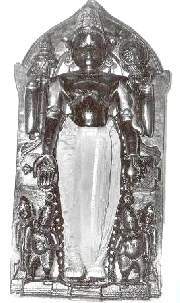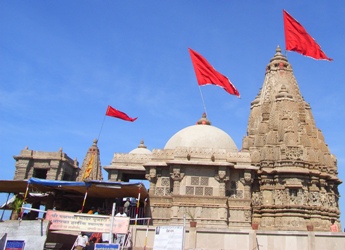|
Lord
Krishna is an incarnation of Lord Vishnu.
According
to Pauranik literature, Lord Krishna settled and established his kingdom at
Dwarka, in Jamnagar, after his migration from Mathura.
Archeological
excavations reveal that the present day Dwarka is the 6th
city on this site, the earlier 5 have submerged in the sea.
India has 4 Main Dhaams, 7 Puris, 108 Devi Peeths, 4 Shardapeeths, 68 Tirth and 12
Jyotirlings.
One Dham Dwarka, One Jyotirling Nageshwar and One Shardapeeth are the 3 places of International importance at Dwarka.
Dwarka : Ancient
name for this area was Kushsthali, then Dwarvati, then Usha mandal then Okha
mandal.
Lord Krishna came to here to Kushthali with his whole
Yadav clan to make a new world for his clan.
This pleasant sea side land, cooled the eyes of Lord
Krishna, so he put the foundation of Dwarka.
This place was full of all the comforts of life so it was
called the Golden city. The city had huge markets, good roads, There
was a fort built around the city and there were 10 Kothas. The Palaces of the
Yadav clan is said to have doors of gold.
Dwarkadhish Temple:

In the middle of the town is the Dwarkadhish Temple,
which was built in the 16th century. Dwarkadish is another name of Lord Krishna
that means the "Lord of Dwarka". The five-storey high temple is built
on seventy-two pillars. The temple spire is 78.3m (235 feet) high. From the
temple dome waves an eighty-four foot long multicolored flag decorated with the
symbols of the sun and moon. Lord Krishna's grandson, Vajranabha, is said to
have built the original temple of Dwarkadhish over the
hari-graha (Lord Krishna's residential place). The sanctum of the temple is
formed by the Jagat Mandir, or Nija Mandir, which dates back at least 2500
years. The Jagat Mandir has a tall tower and a hall of audience. There are two
entrances to the temple. The main entrance(north entrance) is called
"Moksha Dwara" (Door to Salvation). This entrance leads to the main
market. The south entrance is called "Swarga Dwara" (Gate to Heaven).
Outside this doorway are 56 steps that lead to the Gomati River.
The audience hall has both ancient and fairly modem sculptures. The main Deity
in this temple is Lord Dwarkadhish, who is on the central altar. The Deity
represents the four-armed form of Vishnu called Trivikrama. There is a temple
to the right of the main Deity that contains the Deity of Lord Baladevaji
(Balarama), who is the older brother of Lord Krishna. The temple to the left of
the main Deity contains a big Deity of Pradyumna and a small Deity of
Aniruddha. They are the son and grandson of Lord Krishna. Opposite this shrine
is the shrine of Purusottama (Vishnu). Next to this shrine is a shrine dedicated
to Kuseswara Mahadeva (Shiva). The shrine facing Dwarkadhish is dedicated to
Devaki, the mother of Lord Krishna. Next to this shrine is a temple dedicated
to Veni-madhava (Lord Vishnu). Behind the main temple in the eastern part of
the temple compound are shrines of Radhikaji, Jambuvatiji, Satyabhamaji and
Lakshmiji. There are also shrines of Saraswati and Lakshmi-Narayan.
Rukshmaniji Temple:

1.5 Kms from Dwarka on Okha Highway, on the banks of Bhagirathi River,
is the Temple of Rukshmaniji, the Patrani of
Lord Krishna.
You can stop here while going towards Bet - Dwarka.
Gomti Ghat : This is the place where Gomti River meets the Ocean, Pilgirms take the
privialage here for a holy dip. if one wants then they can take a ferry and cross the Ghat and reach the opposite bank and visit the places of Pandavas.
Bet Dwarka :
Also known as Bet Shankhodar, was a full
fledged port before the development of Okha Port. It was the residing of Lord Krishnas
Queens. In the Temple of of the Bet, the idols of the queens
such as Lakshmiji, Radhaji, Satyabhamaji,
Jambuvantiji are main.
On the Island thre are 23 Shivalays, 20 Vaishnav Temples,
9 Hanuman Temples,
6 DeviTemples including other many temples.
The Old Shankhnarayan Temple is belived to be built around V.S 1774.
The Mahaprabhuji Baithak was built here by Shrimad
Vallabhacharyaji in V.S 1535. There is also a place for Balramji.
Bet Dwarka is about 15 minutes ferry ride from from Okha port.
Okha Port: The natural harbour of okha was made into a
port by the Gaikwad Dynasty ruler of Baroda,
Shri Sayaji Rao Gaikwad on 14th February 1926.
Before that in 1925AD,Jamnagar Okha railway line had become operational.
Before Okha port was developed, Arambhada was the main
port and people used this place for going towards Bet Dwarka for
pilgirmage. Mendarda Port was also used for the purpose.
Gopi Talav : Gopis used to take bath in this lake so its called gopi talav. the red mud aroundt the
lake is called `Gopi Chandan' here there are small and big Dharamshalas,
Anandabawa Ashram, Kabir Ashram and Birla Dharamshala.
Shardapeetha: Aadh Shankracharya in 491 AD, founded this
peetha himself as the 4th peeth.
Aadh Sankracharya had founded 4 peeths for withholding
the traditions of India.
Dwarka Shardapeeth operates Sharda Vidyapeeth Art College, an Indian Research Temple and a Museum.
Madhavpur: Lord
Krishna and Rukshmaniji married in Madhavpura, which is 60 KMS from
Porbunder. A large fair is held here in March – April.
Dehotsarg,
at
Treveni
Ghat is
believed to be the site of Lord Krishnas mortal incarnations cremation. The Ahir
community women of this area wear black even today.
|